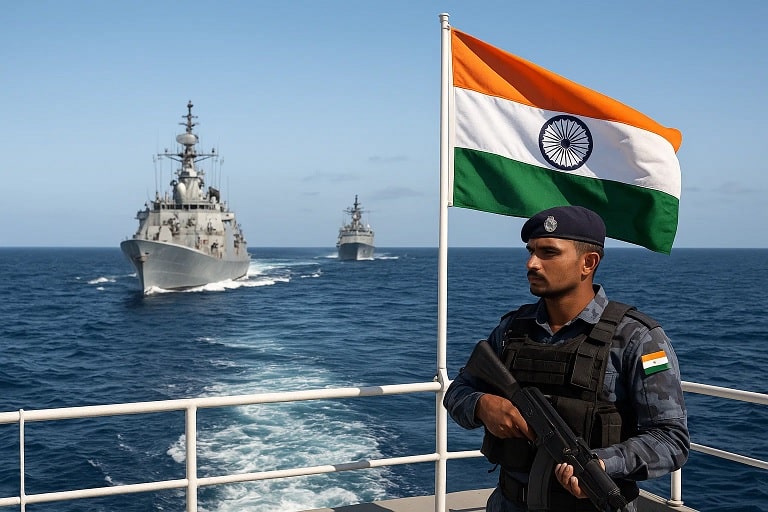New Delhi, August 10, 2025 – India has solidified its position as a preeminent security partner in the Indo-Pacific, propelled by strategic defense collaborations, maritime initiatives, and a proactive foreign policy under Prime Minister Narendra Modi. Surpassing traditional regional powers, India’s ascent is marked by its leadership in multilateral frameworks like the Quad, robust defense exports, and enhanced maritime domain awareness, positioning it as a counterbalance to China’s growing influence. This shift, recognized by allies like Australia and the United States, underscores India’s transformation into a regional powerhouse committed to a free, open, and rules-based Indo-Pacific.
A Strategic Evolution: From Regional Player to Security Leader
India’s journey to becoming a leading Indo-Pacific security partner began with its post-Cold War pivot toward a more assertive foreign policy. The 2015 launch of the Security and Growth for All in the Region (SAGAR) doctrine laid the foundation, emphasizing maritime security and regional cooperation. In 2025, during a visit to Mauritius, Modi unveiled MAHASAGAR (Mutual and Holistic Advancement for Security and Growth Across Regions), an evolved doctrine signaling India’s shift from an Indian Ocean focus to a global maritime vision, particularly amplifying the Global South’s voice.
Former Indian diplomat Suchitra Durai noted that India has “graduated to becoming a preferred security partner,” engaging in joint exercises, capacity building, and exporting defense equipment via grants or Lines of Credit. India’s defense partnerships now span Sri Lanka, Maldives, Mauritius, Bangladesh, and Seychelles under the Colombo Security Conclave, with a formal charter and secretariat established in Colombo. The Indian Ocean Naval Symposium, with 25 member states and India set to assume the chair in late 2025, further cements its regional leadership.
Maritime Security: A Cornerstone of Influence
India’s maritime strategy is central to its Indo-Pacific role. The biennial MILAN exercise, hosted by the Indian Navy, aligns with SAGAR and the Act East policy, fostering multinational cooperation. The Information Fusion Centre – Indian Ocean Region (IFC-IOR) in Gurugram, operational since 2018, enhances maritime domain awareness by sharing real-time data with 22 partner nations via white shipping agreements. This capability counters piracy, illegal fishing, and trafficking, reinforcing India’s role as a net security provider.
Trilateral maritime cooperation with Sri Lanka and Maldives, initiated in 2011, has expanded to include Mauritius and Bangladesh, with Seychelles as an observer. India’s provision of coastal radar systems, patrol vessels, and training to nations like Mauritius and the Maldives strengthens regional security architectures. Recent engagements, such as Modi’s visits to Mauritius, Maldives, and the Philippines in 2025, align with MAHASAGAR’s vision of holistic security and growth.
Defense Exports and Partnerships: A Growing Footprint
India’s defense exports, valued at $2.5 billion in 2024, include advanced systems like the BrahMos supersonic cruise missile, supplied to the Philippines and Vietnam. A $375 million deal with the Philippines in 2022, followed by joint naval drills in the South China Sea in 2025, highlights India’s expanding influence in Southeast Asia. These exports, often funded through concessional Lines of Credit, enhance partner nations’ capabilities while countering China’s regional dominance.
The Quad—comprising India, the U.S., Japan, and Australia—remains a linchpin of India’s strategy. India’s active participation, including the Malabar naval exercise and the 2022 Humanitarian Assistance and Disaster Relief partnership, underscores its commitment to a rules-based order. The 2014 Forum for India-Pacific Islands Cooperation (FIPIC) further strengthens ties with Pacific Island nations, while India’s 2023 G20 presidency, which saw the African Union’s inclusion, amplified its global south advocacy.
Australia’s 2024 National Defence Strategy explicitly named India a “top-tier security partner,” citing deepened cooperation through the Comprehensive Strategic Partnership, including the Mutual Logistics Support Arrangement (MLSA) and joint exercises like AUSINDEX and Malabar. The first deployment of Indian Navy and Air Force assets to Australia’s Cocos Keeling Islands in 2023 exemplifies this synergy.
Countering China: A Delicate Balance
India’s rise is partly a response to China’s assertive maritime presence, particularly in the Indian Ocean, where Beijing’s naval expansion and strategic port investments raise concerns. The International Institute of Strategic Studies noted in 2024 that India’s defense partnerships “counter Beijing’s regional influence,” potentially intensifying Sino-Indian competition. India’s refusal to join U.S.-Australia exercises like Talisman Sabre reflects its strategic autonomy, balancing cooperation with independence.
Geopolitical tensions, such as border disputes with China, add complexity. Australia’s 2024 strategy acknowledged risks of conflict along India’s borders, including nuclear flashpoints, highlighting the high-stakes environment India navigates. Yet, India’s focus on ASEAN centrality and synergy with the ASEAN Outlook on the Indo-Pacific ensures it positions itself as a balancer, not a provocateur.
Economic and Developmental Dimensions
India’s security role is intertwined with its developmental partnerships, guided by the principle of “Vasudhaiva Kutumbakam” (the world is one family). Modi’s 2018 pledge to align cooperation with partner priorities has led to comprehensive aid, including $3.8 billion in Lines of Credit to 40 countries and capacity-building programs. Initiatives like the Indo-Pacific Oceans Initiative (IPOI), launched in 2019, promote practical cooperation in maritime security, ecology, and disaster response.
India’s economic rise supports its security ambitions. Electronics exports, particularly smartphones, surged to $24.1 billion in 2024-25, with India overtaking China as the top U.S. smartphone supplier in Q2 2025. This economic clout, bolstered by the Production Linked Incentive scheme, enhances India’s ability to fund defense modernization and regional partnerships.
Challenges and Opportunities
Despite its progress, India faces hurdles. Asymmetric priorities with partners like Australia, which focuses on Pacific security, contrast with India’s Indian Ocean-centric view. Infrastructure gaps and bureaucratic delays could hinder defense industry growth, though initiatives like DEFEXPO aim to bridge these. China’s potential backlash to India’s rising influence may complicate regional dynamics, requiring deft diplomacy.
Opportunities abound, however. Deepening technological ties with Australia in areas like undersea sensors and joint production, alongside India’s space achievements—such as the 2025 NISAR launch with NASA—could enhance its strategic weight. Expanding IPOI and MLSA implementation offers pathways to strengthen interoperability and regional stability.
Conclusion: A New Indo-Pacific Anchor
India’s emergence as the top Indo-Pacific security partner marks a transformative shift, blending maritime leadership, defense exports, and multilateral engagement. From the Colombo Security Conclave to the Quad, India’s strategic vision, rooted in SAGAR and MAHASAGAR, positions it as a linchpin for a free and inclusive region. As it navigates tensions with China and aligns with allies like the U.S. and Australia, India’s balanced approach—cooperative yet autonomous—signals a new era of influence, reshaping the Indo-Pacific’s security landscape.













